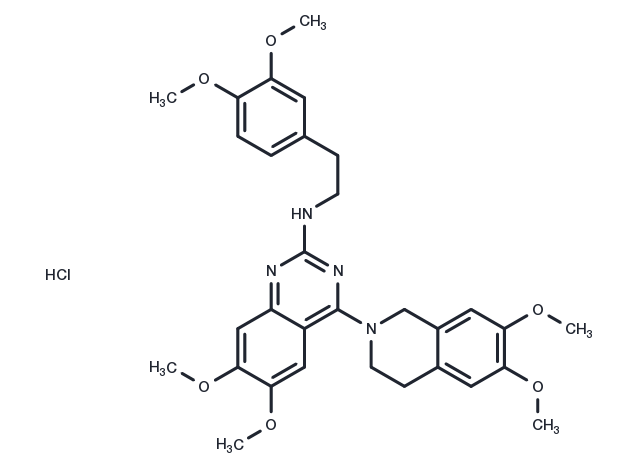store at low temperature
Powder: -20°C for 3 years | In solvent: -80°C for 1 year

CP-100356 hydrochloride is an orally active and low micromolar dual inhibitor of MDR1 (P-gp) and BCRP, a nucleotide-derived substrate analogue with inhibitory effects on MDR1-mediated Calcein-AM transporter and BCRP-mediated Prazosin transporter.CP-100356 Inhibits OATP1B1, induces stomatal opening in the dark.

| Pack Size | Availability | Price/USD | Quantity |
|---|---|---|---|
| 50 mg | 6-8 weeks | $ 747.00 | |
| 100 mg | 6-8 weeks | $ 1,120.00 |

| Description | CP-100356 hydrochloride is an orally active and low micromolar dual inhibitor of MDR1 (P-gp) and BCRP, a nucleotide-derived substrate analogue with inhibitory effects on MDR1-mediated Calcein-AM transporter and BCRP-mediated Prazosin transporter.CP-100356 Inhibits OATP1B1, induces stomatal opening in the dark. |
| Targets&IC50 | MDR1:0.5 µM, BCRP:1.5 µM (in MDCKII cells) |
| In vitro | In human MDR1-transfected MDCKII cells, CP-100356 hydrochloride inhibited acetoxymethyl calcein (calcein-AM) uptake (IC50 approximately 0.5 +/- 0.07 microM) and digoxin transport (IC50 approximately 1.2 +/- 0.1 microM). Inhibition of prazosin transport (IC50 approximately 1.5 +/- 0.3 microM) in human BCRP-transfected MDCKII cells by CP-100356 hydrochloride confirmed the dual MDR1/BCRP inhibitory properties[1]. |
| In vivo | In vivo inhibitory effects of CP-100356 hydrochloride in rats were examined after coadministration with MDR1 substrate fexofenadine and dual MDR1/BCRP substrate prazosin. Coadministration with increasing doses of CP-100356 hydrochloride resulted in dramatic increases in systemic exposure of fexofenadine (36- and 80-fold increase in C(max) and AUC at a CP-100356 hydrochloride dose of 24 mg/kg). Significant differences in prazosin pharmacokinetics were also discernible in CP-100356 hydrochloride-pretreated rats as reflected from a 2.6-fold increase in AUC.[1]. |
| Synonyms | CP-100356 HCl, CP 100356 hydrochloride |
| Molecular Weight | 597.1 |
| Formula | C31H37ClN4O6 |
| CAS No. | 142715-48-8 |
store at low temperature
Powder: -20°C for 3 years | In solvent: -80°C for 1 year
DMSO: 5 mg/mL (8.37 mM), Sonication is recommended.
You can also refer to dose conversion for different animals. More
bottom
Please see Inhibitor Handling Instructions for more frequently ask questions. Topics include: how to prepare stock solutions, how to store products, and cautions on cell-based assays & animal experiments, etc.
CP-100356 hydrochloride 142715-48-8 Membrane transporter/Ion channel BCRP CP-100356 HCl CP-100356 Hydrochloride CP 100356 hydrochloride inhibitor inhibit
